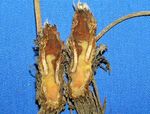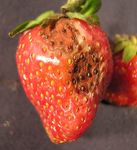PLANT HEALTH CLINIC NEWS - Department of Plant Pathology - UAEX
←
→
Page content transcription
If your browser does not render page correctly, please read the page content below
Department of Plant Pathology
PLANT HEALTH
Sherrie Smith
Keiddy Urrea CLINIC NEWS
Issue-12, May 17, 2021
This bulletin from the Cooperative Extension Plant spring, when buds begin to swell, females
Health Clinic (Plant Disease Clinic) is an electronic penetrate deeper into buds and lay eggs on the
update about diseases and other problems observed in
our lab each month. Input from everybody interested in tissue. Development from egg to adult requires
plants is welcome and appreciated. approximately 20 to 30 days during the spring.
The feeding activity of the mites causes blisters
on developing leaves. As the blisters form, leaf
cells near the center of the blisters die and pull
The Plant Health Clinic now has a apart as surrounding cells enlarge, creating a
Facebook page: hole. Several generations develop within
https://www.facebook.com/UAEXPlantHealt blisters during a growing season. Subsequent
hClinic/?pnref=story generations require only 10 to 12 days to fully
develop. Fruit damage is caused by feeding
injury to buds before bloom. Overwintering
Follow us on blister mites are found beneath the outer bud
Twitter https://twitter.com/AR_PlantClinic scales in October and November. Begin
scouting after harvest. Collect one shoot from
the top and one from eye level from 20 healthy
trees in a block. When three or more shoots
show damage, fruit damage can be expected
https://www.instagram.com/ar_planthealthc the following spring if treatments are not
linic/ar_planthealthclinic applied either postharvest or during dormancy.
In early spring young leaves that are still furled
Pear will show light green to red-rough spots where
the mites have been feeding. Oils or
Pear Blister mite damage can resemble applications of sulfur during the dormant
herbicide injury. However, closer examination season are control options.
under magnification reveals the tiny mites.
Outbreaks of the Pear Blister mite, Eriophyes Pear Blister mite-Eriophyes pyri
pyri, can cause severe damage. The mites
cause brown blisters on the undersides of
leaves and depressed russet spots on fruit.
Heavily damaged fruit may become deformed
and distorted. The blisters begin as small
green pimples on the lower leaf surface. As
the blisters age, they become reddish, then
brown in color. The mite is an extremely small
sausage-shaped mite that overwinters at the
base of buds or under outer bud scales. In Sherrie Smith, University of Arkansas Cooperative Extension
The University of Arkansas System Division of Agriculture offers all its Extension and Research programs to all eligible persons without regard to race,
color, sex, gender identity, sexual orientation, national origin, religion, age, disability, marital or veteran status, genetic information, or any other legally
protected status, and is an Affirmative Action/Equal Opportunity Employer.Department of Plant Pathology
PLANT HEALTH
Sherrie Smith
Keiddy Urrea CLINIC NEWS
Issue-12, May 17, 2021
Pear Blister mite-Eriophyes pyri Pear Blister mite-Eriophyes pyri
Sherrie Smith, University of Arkansas Cooperative Extension
Pear Blister mite-Eriophyes pyri
Keiddy Urrea, University of Arkansas Cooperative Extension
Sherrie Smith, University of Arkansas Cooperative Extension
The University of Arkansas System Division of Agriculture offers all its Extension and Research programs to all eligible persons without regard to race,
color, sex, gender identity, sexual orientation, national origin, religion, age, disability, marital or veteran status, genetic information, or any other legally
protected status, and is an Affirmative Action/Equal Opportunity Employer.Department of Plant Pathology
PLANT HEALTH
Sherrie Smith
Keiddy Urrea CLINIC NEWS
Issue-12, May 17, 2021
Willow Garden-All-in-One
Fungicide/Insecticide/Fertilizer, (tebuconazole
Willow trees remain popular in the landscape. & imidacloprid), or Fertilome 2-N-1 Systemic
Willow scab, caused by the fungus Venturia Fungicide,(tebuconazole & imidacloprid),or
saliciperda, infects Salix species wherever Bonide Infuse Systemic for Turf and
willows are grown. The willow scab fungus is Ornamentals, (thiophanate-methyl), or Ortho
frequently found on willow with an unrelated Rose and Flower Insect and Disease Control,
pathogen, the black canker fungus, Glomerella (triticonazole & acetamiprid).
miyabeana, to produce an extremely
destructive blight of willow. Both pathogens
over-winters as dormant spores in leaves and
Willow Scab- Venturia saliciperda
twigs that were infected last season. The
spores are wind and rain-splashed in the
spring to opening buds and leaves. Infected
leaves and twigs die and fall prematurely to the
ground. During wet weather throughout the
growing season, new spores are produced and
released from the infected debris. Black
canker usually infects leaves and twigs later in
the season than scab. The cankers most often
appear at the nodes underlying petioles. Leaf
blades that become infected turn black near
the base. Leaves will shrivel and drop
prematurely. Homeowners may use Fertilome
Broad Spectrum Lawn and Garden Fungicide,
(chlorothalonil), or Hi-Yield Vegetable, Flower,
Fruit, and Ornamental
Fungicide,(chlorothalonil) or Ortho Maxx
Garden Disease Control, (chlorothalonil), or
Ortho Disease B Gon Garden Fungicide,
(chlorothalonil), or Garden Tech Daconil
Fungicide,(chlorothalonil), or Bonide Fung-onil
Multipurpose Fungicide, (chlorothalonil), or
Spectracide Immunox Plus, (myclobutanil &
permethrin), or Bonide Rose Rx Systemic
Drench, (tebuconazole), or Bayer Advanced
Garden-Disease Control for Roses, Flowers, Sherrie Smith, University of Arkansas Cooperative Extension
Shrubs, (tebuconazole), or Bayer Advanced
The University of Arkansas System Division of Agriculture offers all its Extension and Research programs to all eligible persons without regard to race,
color, sex, gender identity, sexual orientation, national origin, religion, age, disability, marital or veteran status, genetic information, or any other legally
protected status, and is an Affirmative Action/Equal Opportunity Employer.Department of Plant Pathology
PLANT HEALTH
Sherrie Smith
Keiddy Urrea CLINIC NEWS
Issue-12, May 17, 2021
Willow Scab Spores- Venturia Strawberry
saliciperda
Anthracnose Fruit rot is found wherever
strawberries are grown. Three species of the
fungus Colletotrichum have been associated
with anthracnose on strawberry; Colletotrichum
acutatum, Colletotrichum gloeosporioides, and
Colletotrichum fragariae. Chandler, Camarosa,
Treasure, and Albion are popular cultivars that
are particularly susceptible. Symptoms on fruit
appear as brown to black, water-soaked spots
on green and ripe fruit. The lesions become
sunken and firm, turning brown to black. Pink,
salmon, or orange-colored masses of spores
form in the lesion under humid conditions. The
Sherrie Smith, University of Arkansas Cooperative Extension
entire fruit may dry up and become mummified.
Infected flowers may also dry up, or developing
fruit remain small, hard, and misshapen.
Willow Black Canker- Lesions on strawberry stolons and petioles are
Glomerella miyabeana often associated with anthracnose crown rot.
Lesions begin as small red streaks, and rapidly
become dark, sunken, elongated lesions. Pink
spore masses form under humid conditions.
When lesions encircle the stem, its leaf wilts
and dies. The first symptom of anthracnose
crown rot is wilting of the youngest leaves on
the plant. Once the crown rot is extensive, the
entire plant wilts and dies. Anthracnose crown
rot is most often caused by Colletotrichum
fragariae. Anthracnose spores may survive up
to nine months on debris in the field. Spread
and severity of the disease may be reduced by
practices that keep the foliage as dry as
possible. Fields where high rates of nitrogen
are used, especially ammonium sources of
nitrogen, have significantly higher disease
levels. Rotate Captan with Luna Sensation, or
Switch, or CaptEvate, or Elevate, or Fontelis,
Sherrie Smith, University of Arkansas Cooperative Extension
The University of Arkansas System Division of Agriculture offers all its Extension and Research programs to all eligible persons without regard to race,
color, sex, gender identity, sexual orientation, national origin, religion, age, disability, marital or veteran status, genetic information, or any other legally
protected status, and is an Affirmative Action/Equal Opportunity Employer.Department of Plant Pathology
PLANT HEALTH
Sherrie Smith
Keiddy Urrea CLINIC NEWS
Issue-12, May 17, 2021
or Scala. To be effective, sprays should be Strawberry Anthracnose
started before the onset of the disease. Follow Petiole Rot- Colletotrichum
label for best results.
fragariae
Strawberry Anthracnose Fruit
Rot- Colletotrichum acutatum
Sherrie Smith, University of Arkansas Cooperative Extension
Strawberry Anthracnose
Crown Rot- Colletotrichum
fragariae
Sherrie Smith, University of Arkansas Cooperative Extension
Sherrie Smith, University of Arkansas Cooperative Extension
The University of Arkansas System Division of Agriculture offers all its Extension and Research programs to all eligible persons without regard to race,
color, sex, gender identity, sexual orientation, national origin, religion, age, disability, marital or veteran status, genetic information, or any other legally
protected status, and is an Affirmative Action/Equal Opportunity Employer.Department of Plant Pathology
PLANT HEALTH
Sherrie Smith
Keiddy Urrea CLINIC NEWS
Issue-12, May 17, 2021
"This work is supported by the Crop
Protection and Pest Management Program
[grant no. 2017-70006-27279/project
accession no. 1013890] from the USDA
National Institute of Food and Agriculture."
https://nifa.usda.gov/sites/default/files/reso
urce/Powerpt_usda_nifa_horizontal_rgb_30
0.jpg
The University of Arkansas System Division of Agriculture offers all its Extension and Research programs to all eligible persons without regard to race,
color, sex, gender identity, sexual orientation, national origin, religion, age, disability, marital or veteran status, genetic information, or any other legally
protected status, and is an Affirmative Action/Equal Opportunity Employer.You can also read

























































